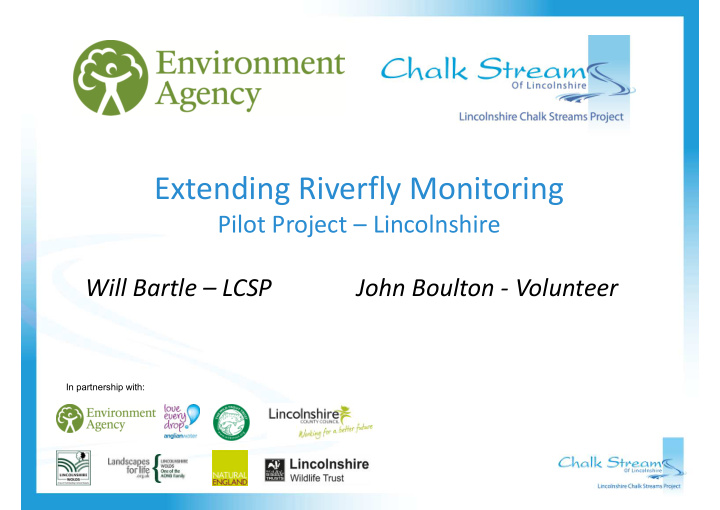



Extending Riverfly Monitoring Pilot Project – Lincolnshire Will Bartle – LCSP John Boulton - Volunteer In partnership with:
Lincolnshire Chalk Streams Project • Partnership organisation set up in 2003 to protect and enhance Lincolnshire’s chalk streams. • As a project we; • Carry out river restoration • Educational projects • Community projects • Volunteers - carrying out Riverfly surveys
Lincolnshire Chalk Streams Project
Why extend Riverfly Monitoring ? • Current 8 taxon designed to pick up water qu quality issues. • Not sensitive enough to pick up other issues such as: • Sedimentation • Flow • Hydromorphology, which influences both
Different stresses - Dr Drought & ab abstraction pressure. • Leads to development of Lotic- invertebrate Index for Flow Evaluation (LIFE) in 1999. • British invertebrates placed in one of six flow-groups based on velocity preference. • Final index is derived from taxa in these groups and adjusted by relative abundance.
Different stresses 2- Se Sedim iment accumula latio ion • Eg - livestock poaching, urban runoff • Metric for this - Proportion of Sediment-sensitive Invertebrates (PSI) • Derives an abundance- weighted ratio of sed sedim iment- sen sensit itive to sed sedim iment-tole lerant taxa (output = 0 - heavily sedimented to 100 - unsedimented)
Extending Riverfly Monitoring 2015 - New pilot system to extend the list of invertebrates devised by: • Ric Richard Ch Chadd – Senior Environmental Monitoring Officer, Analysis and Reporting - Environment Agency • Chr Chris is Ext Extence – Analysis and Reporting Team Leader Environment Agency • Seeks to give indication of water qu qualit ity, fl flow and sed sedim imentation
8 taxa to 26 – Adding information
Surveying methodology Surveying methodology is the same as Riverfly surveying • Standard Riverfly kit is used to kick sample • Transferred to a tray • Abundance of 26 taxa estimated • Abundance of taxa given a score • Scores added together to give final figure • Trigger level set based on existing data
New taxa - Examples Pl Planorbid idae – Ra Ramshorn sna snail ils ‘Found in standing and slow -flowing waters of all sizes’ – FBA’s Guide to Freshwater Invertebrates Therefore could indicate possible flow issue Si Sialidae – Ald lderfly ‘Typically (lives) in mud at the bottom of ponds, lakes and streams .’ – FBA’s Guide to Freshwater Invertebrates Therefore could indicate possible sedimentation issue
Original Riverfly Scoring System Riv Riverfly ly Sc Scorin ing system Abundance of 8 key invertebrates Abundance Category Score 1-9 A 1 10 – 99 B 2 100 – 999 C 3 1000 – 9999 D 4 E.g. Number of stoneflies in kick sample = 40 Category = B Score = 2
New Scoring System • Invertebrates split into 2 groups • Those that indicate fine sediment and low flow • Those that are sensitive to fine sediment and low flow
New Scoring System • Score rises with sediment & flow- sensitive taxa e.g. caseless caddis • Score reduces with rising abundance of fine sediment & low flow indicators e.g. leeches (Original 8 ‘ Riverfly ’ taxon list still operates.)
New Scoring System Pi Pilo lot Proj oject Sc Scorin ing system Sediment and slow flow sensitive taxa i.e. stoneflies Abundance Category Score 1 A1 1 2-9 A 1 10 – 99 B 2 100 – 999 C 3 1000 – 9999 D 4 Sediment and slow flow indicators i.e. true worms Abundance Category Score 1 A1 1 2-9 A 1 10 – 99 B -1 100 – 999 C -2 1000 – 9999 D -3
Example – Hemingby, River Bain 25 th Sep 2016 sample: • Standard Riverfly trigger level – 6 • Results for Riverfly survey – 8 Above trigger level • Pilot Project trigger level – 8 • Results for Pilot Project - 7 Under Trigger • Pilot Project – Addition of true worms Oligochaeta – Indicator of slow flows and fine sedimentation.
Extended list – Training and support May 2015 2015 - Training day held, led by Richard Chadd and Chris Extence
Extended list – Training and support May 2015 2015 - Training included: • Synopsis of water monitoring techniques • ID help for each taxa • Long practical session in afternoon for volunteers to practice
Extended list – Equipment All volunteers provided with: • Key – ‘Guide to freshwater macroinvertebrates for biotic assessment’ • High magnification jeweller’s loupe (10x + 20x) • ID Guide - pictures and ID ‘pointers’
John Boulton, an introduction………….
Email: chalkstreams@lincolnshire.gov.uk Tel: 01522 555780 Web: www.lincswolds.org.uk/chalk-streams Facebook: @LincolnshireChalkStreams Twitter: @LincChalkStream In partnership with:
Pilot Project sampling at Hemingby
A raw Hemingby sample � A very dirty raw sample complete with signal crayfish.
River Bain signal crayfish
Getting down to species level We were faced with the need to get to know much more about our river than ever before. We needed not only to be able to quickly distinguish between Ephemerella ignita and Baetis 'whatever' , but it became increasingly important to get down to species level within Large dark olive dun - Baetis each group. This helped with quick � rhodani? recognition and subsequently reduced our sampling times Baetis scambus? � dramatically. Caenis luctuosa? �
Spotting the unusual � Getting to know your river. � Paraleptophlebia. � Taking things further. � Nitrates to Trout.
Conclusion to practical sampling and the Pilot Project � Understanding the river � Adapting to your conditions � Learning as much as you can about your target species' � Don't expect to find everything on the list! � Do be prepared for the unusual
Email: chalkstreams@lincolnshire.gov.uk Tel: 01522 555780 Web: www.lincswolds.org.uk/chalk-streams Facebook: @LincolnshireChalkStreams Twitter: @LincChalkStream In partnership with:
Recommend
More recommend